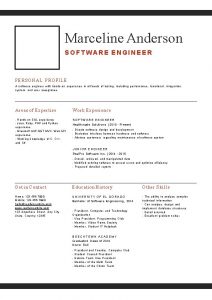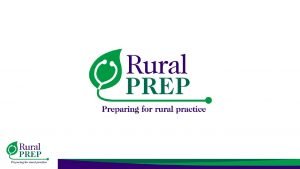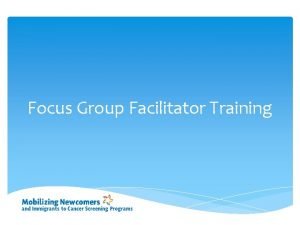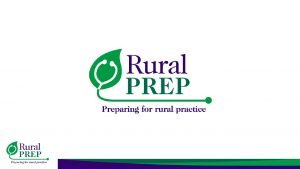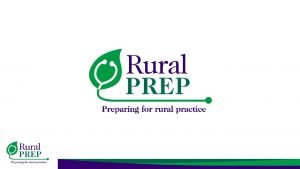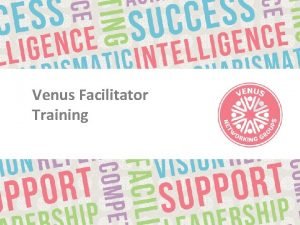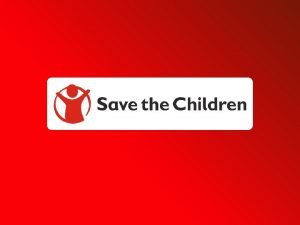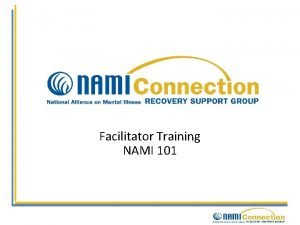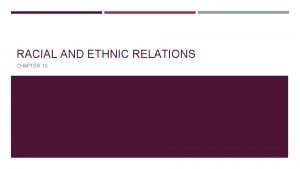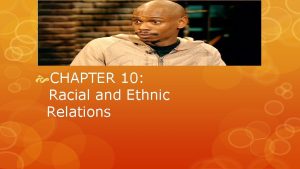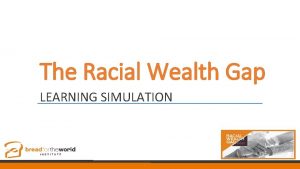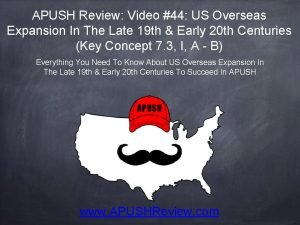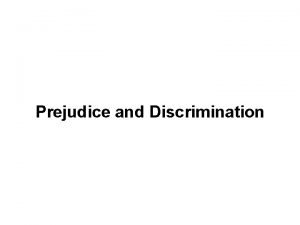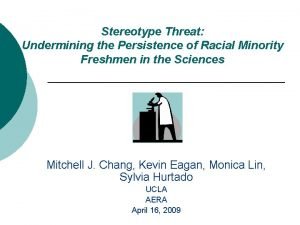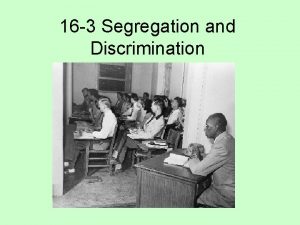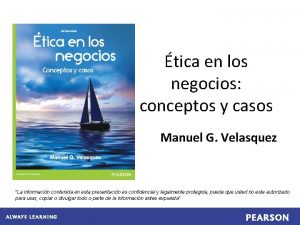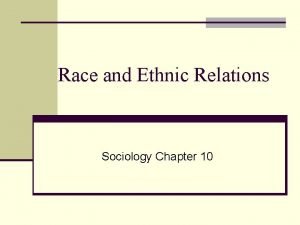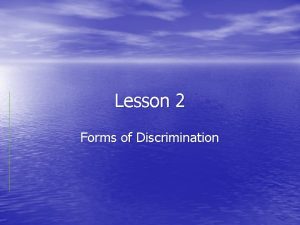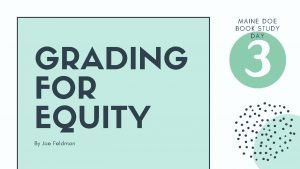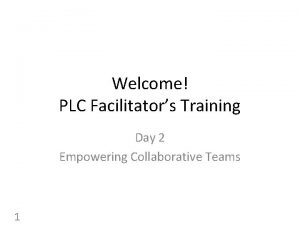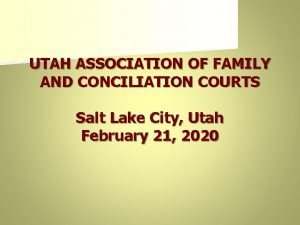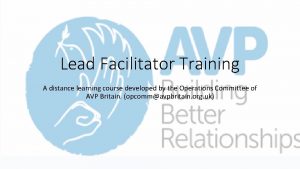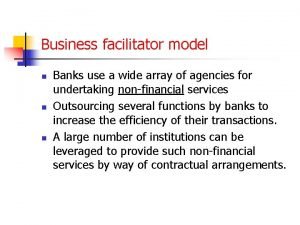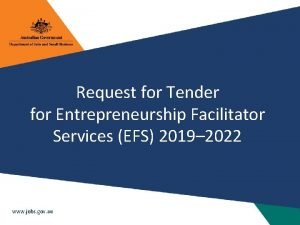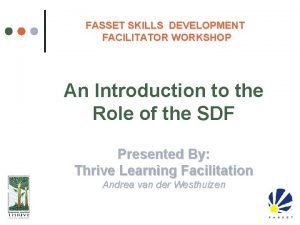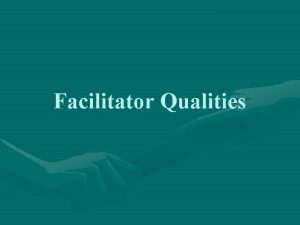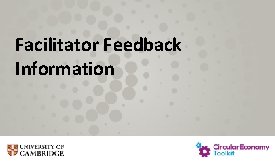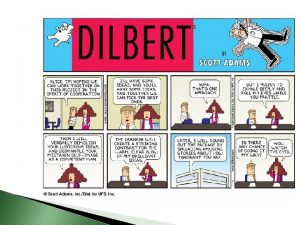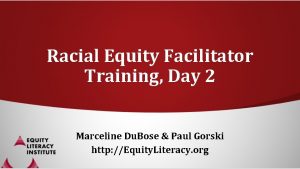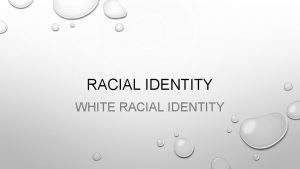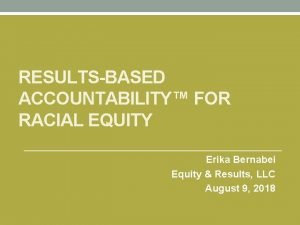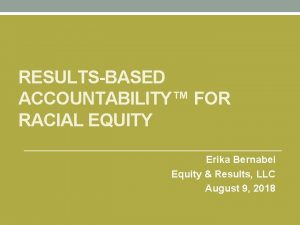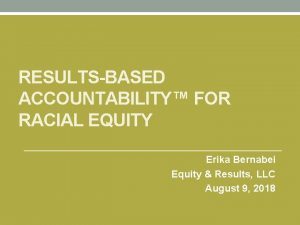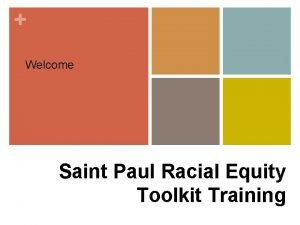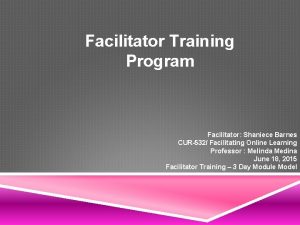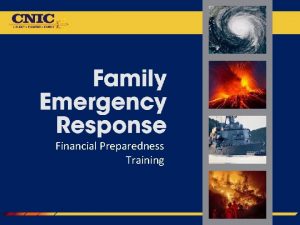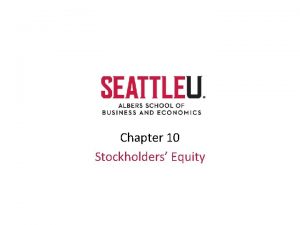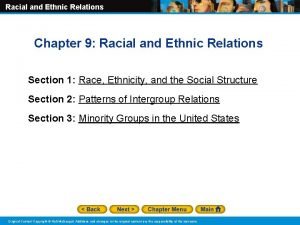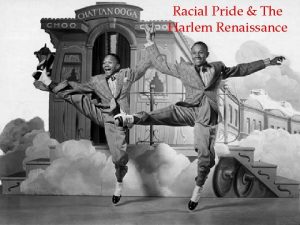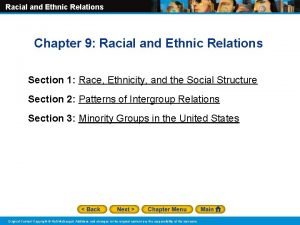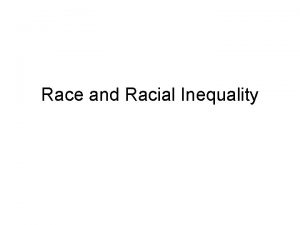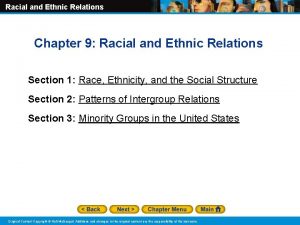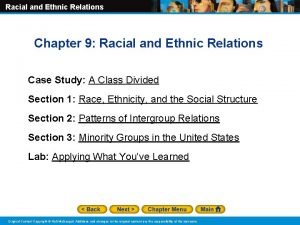Racial Equity Facilitator Training Day 1 Marceline Du
































































- Slides: 64

Racial Equity Facilitator Training, Day 1 Marceline Du. Bose & Paul Gorski http: //Equity. Literacy. org

Welcome • Quick intros • Check-in!—the chat… What is your equity facilitation strength?

A Few Notes • 4 -6: 30 ET, with 15 -minute break • Yes, we are recording • Our work is mostly with schools, universities, and nonprofits; we’ll provide examples from different contexts • We will be using our reflection log (3 minute reflection time between ideas) • Please share your thoughts and questions in the chat!

Reflection (reflection log) • What has been your most heartwarming facilitation moment? • What has been your most frustrating facilitation moment?

Martin Luther King, Jr. “I have almost reached the regrettable conclusion that the Negro's great stumbling block in his stride toward freedom is not the White Citizen's Counciler or the Ku Klux Klanner, but the white moderate, who is more devoted to ‘order’ than to justice; who prefers a negative peace which is the absence of tension to a positive peace which is the presence of justice; who constantly says: ‘I agree with you in the goal you seek, but I cannot agree with your methods of direct action’; …

Back to Martin Luther King, Jr. …Shallow understanding from people of good will is more frustrating than absolute misunderstanding from people of ill will. Lukewarm acceptance is much more bewildering than outright rejection. ”

Racism

Dismantling Racism Works (Dismantling. Racism. org)

Belief or Accumulative Impact of Social Conditions? • “Racism = a system of oppression/advantage based on race” • Note structural/accumulative understanding • I can be advantaged and participate in oppression even if I don’t believe a group is inferior to mine • Can’t just change individual people’s attitudes; have to change systems and structures, too— that “anti-bias” training is not enough (more on this soon)

Layers of Racism

The Layers Sociohistorical Racism Ideological Racism Individual Racism Institutional Racism Cultural Racism Structural Racism

Shift One Racism as solely individual, interpersonal actions Racism as structures of advantage and disadvantage

Shift Two Racism as an occasional incident that needs to be addressed when witnessed or reported Racism as ordinary and impacting everything, so we need to proactively be address it all the time

Shift Three Racism as solely a prejudiced belief system that can be adjusted with anti-bias training Racism as the accumulative impact of institutional, cultural, and structural racial injustice that must be addressed at their ideological, institutional, cultural, and structural core

Understanding “Racial Equity”: Establishing a Shared and Robust Definition

Equity Literacy Framing Questions What are the knowledge and skills I need to be a threat to the existence of inequity in my spheres of influence? Do I have the will to be that threat? Do I have the support to be that threat?

What you know: (reflection log) What is inequity? What is equity? Why is creating a shared definition of equity important for group facilitation?

Components of Equity 1. Distinguishing equity (fairness or justice) and equality (sameness) 2. Identifying and eliminating racism, sexism, heterosexism, transphobia, ableism, and other forms of bias and discrimination 3. Fairly distributing access, opportunity, and participation

Components of Equity, not equality Identify and eliminate bias and inequity Fairly distribute access, opportunity, and participation

1. Distinguishing Equity and Equality • Acknowledging unlevel playing field • How offering equality reproduces inequity (example: stringent tardy policies)

1. Distinguishing Equity and Equality: Awareness Activity (in the chat) • What is an example of a policy or practice in your school, district, or organization that is applied equally but still has a disproportionately negative impact a group of already-marginalized people?

2. Identify and Eliminate Inequity • Not just “giving each person what they need” in terms of individual attention, but also in terms of access to just policies, practices, and institutional culture • Equity as identifying and eliminating inequity

3. Fairly Distribute Access and Opportunity • Who has a say in policies, practices, and institutional culture? Based on whose interests are these formed?

Equity Literacy Definition of “Racial Equity”

Defining Inequity An unfair distribution of material and nonmaterial access and opportunity resulting in outcome and experience disparities that are predictable by race, socioeconomic status, gender identity, home language, or other dimensions of identity.

Defining Inequity: “material and non-material" • Material access • Non-material access

Defining Inequity: “outcome and experience disparities" • Outcome disparities • Experience disparities (access to feelings of belonging, bias-free environments)

Bit of Reflection • Based on our definition of inequity, what is an example of a persisting inequity in your school, district, or organization? Who does the inequity harm? Who does it benefit? • If you know it’s an inequity, why does it persist?

Defining Equity A commitment to action: the process of redistributing access and opportunity to be fair and just. A way of being: the state of being free of bias, discrimination, and identity-predictable outcomes and experiences

So: An equitable classroom, school, or organization is not just one where we focus on individual people’s needs, but one where we: 1. actively identify and eliminate all forms of bias and inequity, and 2. actively develop anti-bias, equitable policies, practices, and cultures.

Distinguishing Mitigative and Transformative Equity

Illustration: Addressing “Homelessness” Mitigative. . . Transformative What are the most common things people and organizations do in response to homelessness —to support people experiencing homelessness?

Parable 1: The Starfish • The “respond” ability of equity literacy—short term reaction • The trouble with the Starfish approach to equity • “Starfish” initiatives?

Parable 2: The Babies in the River • The “redress” ability— transformative change at the roots • The difficulty of transformative approaches • Transformative initiatives?

Illustration: Addressing “Homelessness” Mitigative. . . Transformative Are we addressing the causes of homelessness or helping people who are homeless survive as people who are homeless? (We need to do both, of course. But we actually need to do both. )

Reflections (reflection log) • What are examples of things your organization does in the name of racial equity that might nibble around the edges of inequity but don’t actually create more equity? • What would a transformative equity approach look like?

Avoiding Equity Detours

What Do We Mean by Equity Detours? • Things we might do to create the optics of equity progress • Ways we might avoid the hard work of equity by focusing on things that are more manageable and less transformative

Pacing for Privilege Detour • Pacing equity work in a way that prioritizes the comfort and interests of people with privilege over progress toward equity. • Example: “We’re not ready for that. ”

Deficit Ideology Detour • Focusing on adjusting the cultures, mindsets, values, emotions, or grittiness of people who are marginalized rather than adjusting the conditions that marginalize people, like racism. • Example: Gap between strategies to address discipline disproportionality and the actual causes of discipline disproportionality.

Celebrating Diversity Detour • Mistaking celebrations of diversity for progress toward equity. • Example: “Diverse Friends Day” and why celebrating diversity in the absence of racial justice is for white people.

Colorblindness Detour • Trying to address racism by pretending race doesn’t exist

Shiny New Thing Detour • Relying on popular programs and initiatives that were never designed with equity in mind to do the equity work for us

Individualizing Equity Detour • Focusing only on implicit bias or interpersonal conflicts rather than institutional inequity as embedded in policies, practices, and systems

Reflection Which detour do you struggle with personally? Which do you see operating most prominently in your organization? What is it about the institutional culture that results in the detour being so prevalent? • • • Pacing for privilege Deficit ideology Celebrating diversity Colorblindness Shiny new thing Individualizing equity

Basic Equity Literacy Principles

Direct Confrontation Principle • A racial equity commitment requires direct confrontations with inequity. Avoid strategies, programs, and initiatives that are not a threat to inequity. • Identify the inequity, eliminate the inequity, develop actively equitable policies, practices, and institutional cultures.

Prioritization Principle • We must actively prioritize the interests of people whose interests historically have not been prioritized. • The institutional racism trouble with defining equity only as “giving all people what they need. ” Equity is about individual access and institutional change.

Equity Ideology Principle • Equity requires more than practical strategies. It is a lens and an ideological commitment. Sustainable shifts in practice are driven by ideological shifts.

Evidence-Informed Principle • Our equity efforts should be based on evidence for what works rather than what is trendy. “Evidence” can mean big quantitative studies, but it also can mean the stories of people who are marginalized in your institution.

#Fix. Injustice. Not. People Principle • Equity efforts never focus on “adjusting” the cultures, mindsets, values, emotions, or attitudes people from marginalized groups. They always focus on transforming conditions that marginalize and oppress people from marginalized groups.

Reflection Which of these principles would be the most transformative to your racial equity work? Which makes you most anxious? Which would illicit the most resistant in your organization? • Direct confrontation • Prioritization • Equity ideology • Evidence-informed • Fix Injustice, Not People

Five Abilities

Purpose of the Five Abilities • They allow us to apply a strong equity lens to everything we do • They provide an outline for what the thrust of equity professional learning ought to focus on

Equity Literacy Abilities Recognize inequity Respond to inequity Redress inequity Actively cultivate equity Sustain equity

1. Recognize Inequity • Do I recognize even the subtlest bias and inequity in my sphere of influence? • I can’t respond to or redress an inequity I don’t recognize

2. Respond to Inequity • When a bias or inequity becomes apparent in a particular instance, do I have the skills and the will to respond? • Reactive, in the immediate term

3. Redress Inequity • Do I have the knowledge and skills to understand how individual instances of inequity are usually related to bigger sets of conditions related to individual ideology and institutional culture? Am I able to redress those instances by proactively addressing their root causes?

4. Actively Cultivate Equity • Do I have the knowledge, skills, and will to apply an equity lens to every discussion, every decision? Is equity an add-on or afterthought or do I actively cultivate it through every policy and practice and throughout institutional culture?

5. Sustain Equity • As we progress toward a full equity commitment, people who are used to the advantage of extra access and opportunity are going to complain and attempt to slow or reverse that progress. Do I know how to sustain equity efforts in the face of this pushback? Do I have the will to do so?

Using Case Studies

Quick Notes • We’ll look at the one linked on the resources page, Family Night • Ours are mostly about education or working with youth, but feel free to modify

Case Study Analysis Framework • See this week’s tools and resources • How we use case studies • Walking through an example

http: //equity-literacy. thinkific. com http: //Equity. Literacy. org gorski@Equity. Literacy. org @pgorski / @Equity. Literacy
 Day 1 day 2 day 3 day 4
Day 1 day 2 day 3 day 4 Aggression replacement training facilitator training
Aggression replacement training facilitator training Marceline anderson
Marceline anderson Day 1 day 2 day 817
Day 1 day 2 day 817 Games workshop application letter
Games workshop application letter Thank you message to training facilitator
Thank you message to training facilitator Focus group facilitator training
Focus group facilitator training Thank you note to facilitator
Thank you note to facilitator Thank you for your facilitation
Thank you for your facilitation How to thank a training facilitator
How to thank a training facilitator Schwartz rounds facilitator training
Schwartz rounds facilitator training Focus group facilitator training
Focus group facilitator training Nami facilitator training
Nami facilitator training Jim crow laws in what region or regions did it exist
Jim crow laws in what region or regions did it exist Timid bigot example
Timid bigot example Chapter 10 racial and ethnic relations
Chapter 10 racial and ethnic relations Black studies and the racial mountain
Black studies and the racial mountain Racial wealth gap simulation
Racial wealth gap simulation Promoting racial literacy in schools
Promoting racial literacy in schools Racial theories apush
Racial theories apush Racial prejudice
Racial prejudice Tiburcio de espadana role in el filibusterismo
Tiburcio de espadana role in el filibusterismo Racial insults
Racial insults Chapter 16 section 3 segregation and discrimination
Chapter 16 section 3 segregation and discrimination Cartel ley organica contra la discriminacion racial
Cartel ley organica contra la discriminacion racial Chapter 10 racial and ethnic relations review worksheet
Chapter 10 racial and ethnic relations review worksheet Democracia racial
Democracia racial Lesson 2 racial discrimination
Lesson 2 racial discrimination Grading for equity
Grading for equity Schoolmax gradebook
Schoolmax gradebook Oceans apart day after day meaning
Oceans apart day after day meaning Day to day maintenance
Day to day maintenance Physical science chapter 6 review answers
Physical science chapter 6 review answers I don't know tomorrow
I don't know tomorrow Romeo and juliet sunday
Romeo and juliet sunday Growing day by day
Growing day by day Seed germination inhibitors examples
Seed germination inhibitors examples Conclusion of seed germination
Conclusion of seed germination Geotropism
Geotropism I live for jesus day after day
I live for jesus day after day Dying he saved me buried he carried
Dying he saved me buried he carried Day one day one noodle ss2
Day one day one noodle ss2 Dayone dayone noodles ss2 小時光 肆號麵鋪
Dayone dayone noodles ss2 小時光 肆號麵鋪 Unwrap core standard
Unwrap core standard Vdoe math pathways
Vdoe math pathways Family facilitator manual utah
Family facilitator manual utah Authority style of teaching
Authority style of teaching Facilitator course distance learning
Facilitator course distance learning Facilitátor feladatai
Facilitátor feladatai Fldg structure
Fldg structure Entrepreneurship facilitator services
Entrepreneurship facilitator services Ofo codes fasset
Ofo codes fasset Family law facilitator
Family law facilitator Qualities of facilitator
Qualities of facilitator Facilitator feedback survey
Facilitator feedback survey Peer facilitator quotes
Peer facilitator quotes Stemmehører facilitator
Stemmehører facilitator David keirsey
David keirsey Thank you for your facilitation
Thank you for your facilitation Sprint facilitator
Sprint facilitator Akpsi fraternal exam
Akpsi fraternal exam Business facilitation program visa
Business facilitation program visa Facilitator
Facilitator Facilitator
Facilitator Prepare/enrich facilitator manual
Prepare/enrich facilitator manual


